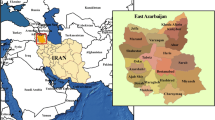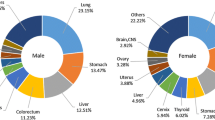Abstract
Background
The National Cancer Database (NCDB) is a hospital-based cancer registry that includes diagnostic, staging, treatment, and outcomes data for newly diagnosed cancer patients in the United States. The NCDB data include 31 million records for patients diagnosed between 1985–2015. A Participant User File based on a subset of these data has been available to researchers at facilities accredited by the Commission on Cancer since 2010. This study aimed to compare the number of incident cancer cases in the NCDB with a national population cancer registry.
Methods
Incident cancer cases in the NCDB in 2012–2014 were compared with the number of cancer cases in the United States Cancer Statistics data for the 2012–2014 diagnosis years. Comparisons were made by primary site and other factors.
Results
In 2012–2014, the NCDB captured 72% of the cancer cases in the United States, which was slightly higher than the 67% and 69% reported respectively in two prior assessments. Among the top 10 major cancer sites, the highest coverage (80%) was found for breast cancer, and the lowest was found for melanoma of the skin (52%) and prostate (58%). Colon, bladder, and kidney and renal pelvis cancers had relatively high coverage of 71%, 70% and 78%, respectively, whereas lung and bronchus had slightly lower coverage (65%).
Conclusions
The NCDB coverage of U.S. cancer cases has remained relatively high (72%), but differences remain by cancer site and other factors that should be taken into account by users of the NCDB data.

Similar content being viewed by others
References
Steele GD, Winchester DP, Menck, HR. The National Cancer Data Base. Cancer. 1994;73:499–504.
American College of Surgeons. National Cancer Database. Retrieved 11 July 2018 at https://www.facs.org/quality-programs/cancer/ncdb.
Bilimoria K, Stewart AK, Winchester DP, Ko, CY. The National Cancer Data Base: a powerful initiative to improve cancer care in the United States. Ann Surg Oncol. 2008;15:683–90.
Lerro CC, Robbins AS, Phillips JL, Stewart AK. Comparison of cases captured in the National Cancer Data Base with those in population-based Central Cancer Registries. Ann Surg Oncol. 2013;20:1759–65.
U.S. Cancer Statistics Working Group. United States Cancer Statistics: 1999–2014 Incidence and Mortality Web-based Report. U.S. Department of Health and Human Services, Centers for Disease Control and Prevention and National Cancer Institute, Atlanta, GA, 2017. Retrieved 26 July 2018 at www.cdc.gov/uscs.
National Cancer Institute. Surveillance, epidemiology, end results program. Site Recode. Retrieved 30 May 2018 at https://seer.cancer.gov/siterecode/.
Health Resources and Services Administration Data Warehouse. Bureau of Health Workforce (BHW). National Center for Health Workforce Analysis (NCHWA). Area Health Resources Files. State and National Level Data. Retrieved 2 May 2018 at https://datawarehouse.hrsa.gov/data/datadownload.aspx.
United States Census Bureau. U.S. Department of Commerce. The American Indian and Alaska Native Population 2010. Retrieved 31 May 2018 at https://www.census.gov/prod/cen2010/briefs/c2010br-10.pdf.
Centers for Disease Control and Prevention. United States Cancer Statistics USCS. Interpreting Race and Ethnicity in Cancer Data. Retrieved 31 May 2018 at https://www.cdc.gov/cancer/npcr/uscs/technical_notes/interpreting/race.htm.
Henry J. Kaiser Family Foundation. State Health Facts. Population distribution by race/ethnicity. Retrieved 30 May 2018 at https://www.kff.org/other/state-indicator/distribution-by-raceethnicity/?currentTimeframe=0&sortModel=%7B%22colId%22:%22Location%22,%22sort%22:%22asc%22%7D.
Centers for Disease Control and Prevention. United States Cancer Statistics. USCS Publication Criteria. Retrieved 31 May 2018 at https://www.cdc.gov/cancer/npcr/uscs/technical_notes/criteria.htm.
American College of Surgeons. Quality Programs. National Cancer Database. Participant User Files. Retrieved 1 June 2018 at https://www.facs.org/quality-programs/cancer/ncdb/puf.
Acknowledgment
The USCS data were provided by central cancer registries participating in the Centers for Disease Control (CDC)’s National Program of Cancer Registries (NPCR) and/or NCI’s Surveillance, Epidemiology, and End Results (SEER) Program and submitted to CDC and NCI in November, 2016. Reda Wilson from the CDC provided useful comments and feedback.
Author information
Authors and Affiliations
Corresponding author
Additional information
Publisher's Note
Springer Nature remains neutral with regard to jurisdictional claims in published maps and institutional affiliations.
Rights and permissions
About this article
Cite this article
Mallin, K., Browner, A., Palis, B. et al. Incident Cases Captured in the National Cancer Database Compared with Those in U.S. Population Based Central Cancer Registries in 2012–2014. Ann Surg Oncol 26, 1604–1612 (2019). https://doi.org/10.1245/s10434-019-07213-1
Received:
Published:
Issue Date:
DOI: https://doi.org/10.1245/s10434-019-07213-1




